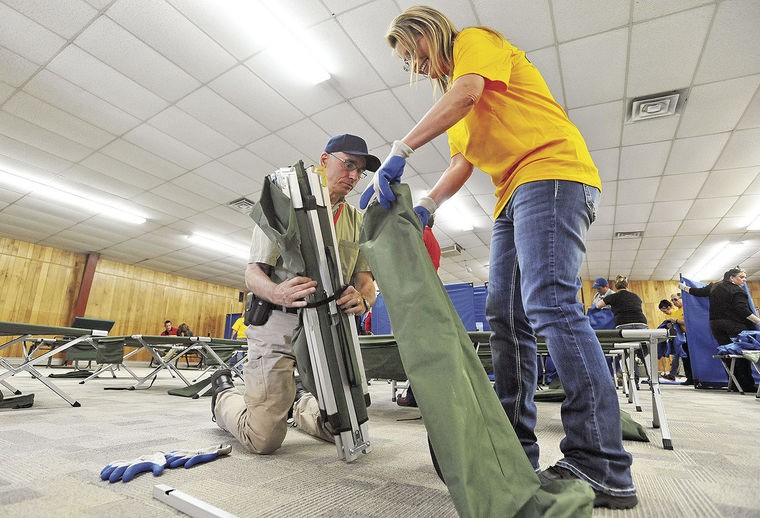The walls shake violently and a rumbling sound — much like an airplane engine whirling overhead — threatens to rip apart the ceiling of your home or office.
Outside, the ground shifts leaving monstrous pits in the earth, from which fervid flames erupt into the night sky overwhelming flashing lights from emergency response vehicles. Homes, bridges and businesses, many of which had lasted generations, crumble.
Welcome to Southeast Idaho’s great earthquake. Though this imagined scenario leaves many wondering "what if," what people should be asking is when.
According to a recent report by the U.S. Geological Survey (USGS), it's more than 63 percent likely that over the next 50 years a 6.0 magnitude or higher earthquake will hit Southeast Idaho near the Bear Lake Fault.
And any earthquake greater than 5.0 on the Richter scale could cause over $250 million dollars in damage to structures, roads and bridges in the counties of Bear Lake, Caribou, Franklin and Oneida, according to earthquake simulation data analyzed by Bengal Solutions, a business consulting team out of Idaho State University’s College of Business.
“We don’t think that it will be 50 years from now, it could be, but it could also happen tomorrow,” said Dan Cravens, director of Bengal Solutions. “We just don’t know. But we do know that the effect of a major earthquake will be very, very significant.”
The Idaho Office of Emergency Management asked Bengal Solutions to study the economic impact of a major earthquake in the counties of Bear Lake, Caribou, Franklin and Oneida.
These counties were selected because of their proximity to the Bear Lake Fault and the substantial number of older buildings, much like those found in Wells, Nevada.
In 2008, a 6.0 magnitude earthquake hit the rural northern Nevada community of Wells. A total of 700 buildings in the town of 1,600 residences suffered damage. Overall, the monetary damage in Wells was millions of dollars, and the community never fully recovered, Cravens said.
The damage from the initial shockwave is just the beginning, however, with additional economic damages likely to follow. These would result from subsequent interruptions because of transportation delays, business closures and residents leaving the community.
“An earthquake’s worst damage often comes after the incident itself,” Cravens said. “Aftershocks of a magnitude close to that of the major quake do additional damage to buildings, utilities and infrastructure. Economically, the community comes to a standstill. As we see from the 2008 Wells, Nevada, earthquake, many businesses close, people leave the community and the community all too often lacks the ability to fully recover.”
Last month, the Bengal Solutions team presented its findings to Idaho Lt. Gov. Brad Little.
“This information is helpful and will help me to ask the right questions of state agencies,” Little said. “The data provided will help our state better protect and serve the citizens of Southeast Idaho potentially effected by earthquakes.”
Hassan Afzal, a graduate student involved with the study, said the data collected will help county commissioners prepare grant requests to secure additional funding for earthquake preparedness.
“This experience has been so fulfilling and rewarding because we are actually doing something that will make a difference,” Afzal said. “This is an opportunity to leave a legacy in this region, and this study could literally help save lives and businesses in this community.”
A large earthquake has the potential to completely isolate some of the smaller communities in Southeast Idaho, destroying gas lines, cellphone towers and power poles and transformers.
“The sooner we prepare for an earthquake, the better and higher level of security and safety we can provide to citizens of Southeast Idaho,” Cravens said. “By providing the information and the tools that allow our county and state governments to respond, we have a higher chance of limiting the damage caused by these earthquakes.”
On Thursday, Hassan and the Bengal Solutions team will present these findings at the Wasatch Wobble, an event that starts at 8 a.m. in the Little Wood River Room in ISU’s Pond Student Union. The event incorporates multiple agencies from around the region that will disseminate the information to the four targeted counties.
In addition to the study conducted by the Bengal Solutions team, Southeastern Idaho Public Health and the Idaho Office of Emergency Management conducted a full-scale earthquake exercise throughout Southeastern Idaho on Wednesday.
The scenario focused on the transition from response to recovery after a hypothetical 6.2 earthquake struck near Logan, Utah, causing death, injury and infrastructure damage.
Devin Hughes, a health liaison with Southeastern Idaho Public Health, said the exercise focused on mobilizing recovery teams in affected areas after the initial shock and dust has settled.
The exercise included two Public Health medical shelters set up at the Franklin County Fairgrounds in Preston. It also featured additional assistance with the American Red Cross to establish a Multi-Agency Resource Center at the fire station in Malad.
“The nice thing about a drill is we can take a step back and assess what’s going on,” Hughes said. “We’re able to talk about the strengths and weaknesses, and establish a plan with a real-life event when stress levels are much higher.”
Both Cravens and Hughes quoted Benjamin Franklin saying, “An ounce of prevention is worth a pound of cure.”
And as far as preparing for an earthquake in Southeast Idaho goes, that quote rings true because it’s not a matter of "what if," it’s a matter of when.



